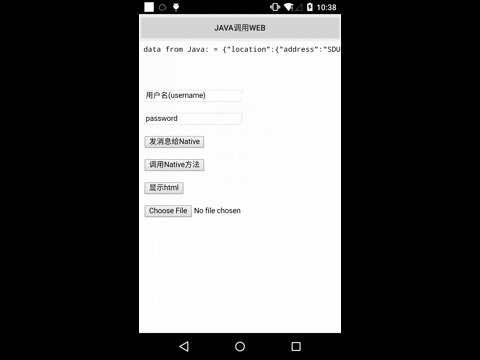JsBridge
Inspired and modified from this and WeChat jsBridge file, with some bug fixes and feature enhancements.
This project makes a bridge between Java and JavaScript.
It provides a safe and convenient way to call Java code from JavaScript and call JavaScript code from Java.
How JsBridge Works

Demo

Usage
JitPack.io
I strongly recommend JitPack.io
repositories {
// ...
maven { url "https://jitpack.io" }
}
dependencies {
compile 'com.github.lzyzsd:jsbridge:1.0.4'
}
Use it in Java
Add com.github.lzyzsd.jsbridge.BridgeWebView to your layout, it is inherited from WebView.
Register a Java handler function so that JavaScript can call
webView.registerHandler("submitFromWeb", new BridgeHandler() {
@Override
public void handler(String data, CallBackFunction function) {
Log.i(TAG, "handler = submitFromWeb, data from web = " + data);
function.onCallBack("submitFromWeb exe, response data from Java");
}
});
JavaScript can call this Java handler method "submitFromWeb" through:
WebViewJavascriptBridge.callHandler(
'submitFromWeb'
, {'param': str1}
, function(responseData) {
document.getElementById("show").innerHTML = "send get responseData from java, data = " + responseData
}
);
You can set a default handler in Java, so that JavaScript can send messages to Java without an assigned handlerName
webView.setDefaultHandler(new DefaultHandler());
window.WebViewJavascriptBridge.doSend(
data
, function(responseData) {
document.getElementById("show").innerHTML = "responseData from java, data = " + responseData
}
);
Register a JavaScript handler function so that Java can call
WebViewJavascriptBridge.registerHandler("functionInJs", function(data, responseCallback) {
document.getElementById("show").innerHTML = ("data from Java: = " + data);
var responseData = "Javascript Says Right back aka!";
responseCallback(responseData);
});
Java can call this JavaScript handler function "functionInJs" through:
webView.callHandler("functionInJs", new Gson().toJson(user), new CallBackFunction() {
@Override
public void onCallBack(String data) {
}
});
You can also define a default handler using the init method, so that Java can send messages to JavaScript without an assigned handlerName
For example:
window.WebViewJavascriptBridge.init(function(message, responseCallback) {
console.log('JS got a message', message);
var data = {
'Javascript Responds': 'Wee!'
};
console.log('JS responding with', data);
responseCallback(data);
});
webView.send("hello");
will print 'JS got a message hello' and 'JS responding with' in webview console.
Persistent Callbacks (New Feature)
By default, callbacks are deleted after first use. However, you can now use persistent callbacks that can be reused multiple times:
Java Side
// Use persistent callback that won't be deleted after first use
webView.callHandlerPersistent("functionInJs", data, new OnBridgeCallback() {
@Override
public void onCallBack(String data) {
// This callback can be called multiple times
Log.d(TAG, "Persistent callback called: " + data);
}
});
JavaScript Side
// Use persistent callback
WebViewJavascriptBridge.callHandlerPersistent("javaHandler", data, function(response) {
// This callback can be reused multiple times
console.log("Persistent callback response: " + response);
});
// Register and manually manage persistent callbacks
var callbackId = "my_persistent_callback";
WebViewJavascriptBridge.registerPersistentCallback(callbackId, function(data) {
console.log("Persistent callback called: " + data);
});
// Remove persistent callback when no longer needed
WebViewJavascriptBridge.removePersistentCallback(callbackId);
This feature is useful when you need to maintain a long-term communication channel between Java and JavaScript, such as for real-time updates or event notifications.
Switch to CustomWebView
- activity_main.xml
<com.github.lzyzsd.jsbridge.example.CustomWebView
android:id="@+id/webView"
android:layout_width="match_parent"
android:layout_height="match_parent" >
</com.github.lzyzsd.jsbridge.example.CustomWebView>
- MainActivity.java Change BridgeWebView class to CustomWebView:
CustomWebView webView = (CustomWebView) findViewById(R.id.webView);
Notice
This library will inject a WebViewJavascriptBridge Object to the window object.
You can listen to the WebViewJavascriptBridgeReady event to ensure window.WebViewJavascriptBridge exists, as the below code shows:
if (window.WebViewJavascriptBridge) {
//do your work here
} else {
document.addEventListener(
'WebViewJavascriptBridgeReady'
, function() {
//do your work here
},
false
);
}
Or put all JsBridge function call into window.WVJBCallbacks array if window.WebViewJavascriptBridge is undefined, this task queue will be flushed when WebViewJavascriptBridgeReady event triggered.
Copy and paste setupWebViewJavascriptBridge into your JS:
function setupWebViewJavascriptBridge(callback) {
if (window.WebViewJavascriptBridge) {
return callback(WebViewJavascriptBridge);
}
if (window.WVJBCallbacks) {
return window.WVJBCallbacks.push(callback);
}
window.WVJBCallbacks = [callback];
}
Call setupWebViewJavascriptBridge and then use the bridge to register handlers or call Java handlers:
setupWebViewJavascriptBridge(function(bridge) {
bridge.registerHandler('JS Echo', function(data, responseCallback) {
console.log("JS Echo called with:", data);
responseCallback(data);
});
bridge.callHandler('ObjC Echo', {'key':'value'}, function(responseData) {
console.log("JS received response:", responseData);
});
});
It's the same as WebViewJavascriptBridge, which makes it easier for you to define the same behavior across different platforms between Android and iOS, while writing concise code.
License
This project is licensed under the terms of the MIT license.
